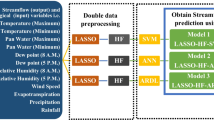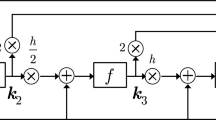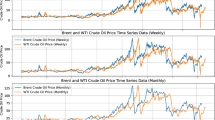Abstract
Landslide displacement system is generally characterized by non-stationary and nonlinear characteristics. Traditionally, many artificial neural network (ANN) models have been proposed to forecast landslide displacement. However, the underlying non-stationary characteristics in the landslide displacement are not captured, and the input–output variables of the ANN models are not selected nonlinearly. To overcome these drawbacks, this paper proposes the chaos theory-based discrete wavelet transform (DWT)–extreme learning machine (ELM) model to predict landslide displacement. The DWT method is adopted to decompose the landslide displacement into several low- and high-frequency components to address the non-stationary characteristics. And chaos theory is used to determine the input–output variables of the ELM model. The cumulative displacement time series of the Baishuihe and Baijiabao landslides in the Three Gorges Reservoir Area, China, are used as data sets. The results show that the chaotic DWT-ELM model accurately predicts landslide displacement. The chaotic DWT–support vector machine (SVM), chaotic DWT–back-propagation neural network (BPNN) and single chaotic ELM models are used for comparisons. The comparison results show that the chaotic DWT-ELM model achieves higher prediction accuracy than do the chaotic DWT-SVM, chaotic DWT-BPNN and the single chaotic ELM models.
















Similar content being viewed by others
References
Acharya N, Shrivastava NA, Panigrahi B, Mohanty U (2014) Development of an artificial neural network based multi-model ensemble to estimate the northeast monsoon rainfall over south peninsular India: an application of extreme learning machine. Clim Dyn 43:1303–1310
Adamowski J, Chan HF (2011) A wavelet neural network conjunction model for groundwater level forecasting. J Hydrol 407:28–40
An X, Jiang D, Liu C, Zhao M (2011) Wind farm power prediction based on wavelet decomposition and chaotic time series. Expert Syst Appl 38:11280–11285
Cai Z, Xu W, Meng Y, Shi C, Wang R (2016) Prediction of landslide displacement based on GA-LSSVM with multiple factors. Bull Eng Geol Environ 75(2):637–646
Cao J, Lin X (2008) Study of hourly and daily solar irradiation forecast using diagonal recurrent wavelet neural networks. Energy Convers Manag 49:1396–1406
Cao Y, Yin K, Alexander DE, Zhou C (2015) Using an extreme learning machine to predict the displacement of step-like landslides in relation to controlling factors. Landslides 13(Suppl 2):1–12
Catalão J, Pousinho H, Mendes V (2011) Short-term wind power forecasting in Portugal by neural networks and wavelet transform. Renew Energy 36:1245–1251
Chen H, Zeng Z (2013) Deformation prediction of landslide based on improved back-propagation neural network. Cognit Comput 5:56–62
Chuang C-W, Lin C-Y, Chien C-H, Chou W-C (2011) Application of Markov-chain model for vegetation restoration assessment at landslide areas caused by a catastrophic earthquake in Central Taiwan. Ecol Model 222:835–845
Cortes C, Vapnik V (1995) Support-vector networks. Mach Learn 20:273–297
Daubechies I (1992) Ten lectures on wavelets, vol 61. SIAM, Philadelphia
Du J, Yin K, Lacasse S (2013) Displacement prediction in Colluvial landslides, three Gorges reservoir. China Landslides 10:203–218
Eberhart RC, Kennedy J (1995) A new optimizer using particle swarm theory. In: Proceedings of the sixth international symposium on micro machine and human science. New York, NY, pp 39–43
Feng X-T, Zhao H, Li S (2004) Modeling non-linear displacement time series of geo-materials using evolutionary support vector machines. Int J Rock Mech Min Sci 41:1087–1107
Feng G, Huang G-B, Lin Q, Gay R (2009) Error minimized extreme learning machine with growth of hidden nodes and incremental learning. IEEE Trans Neural Netw 20:1352–1357
Gani A, Siddiqa A, Shamshirband S, Hanum F (2016) A survey on indexing techniques for big data: taxonomy and performance evaluation. Knowl Inf Syst 46:241–284
Goh A (1995) Back-propagation neural networks for modeling complex systems. Artif Intell Eng 9:143–151
Grassberger P, Procaccia I (1983) Characterization of strange attractors. Phys Rev Lett 50:346–349
Grinsted A, Moore JC, Jevrejeva S (2004) Application of the cross wavelet transform and wavelet coherence to geophysical time series. Nonlinear Process Geophys 11:561–566
Han M, Wang Y (2009) Analysis and modeling of multivariate chaotic time series based on neural network. Expert Syst Appl 36:1280–1290
Hegger R, Kantz H (1999) Improved false nearest neighbor method to detect determinism in time series data. Phys Rev E 60:4970–4973
Huang F, Tian Y (2014) WA-VOLTERRA coupling model based on chaos theory for monthly precipitation forecasting earth science. J China Univ Geosci 3:14
Huang G-B, Zhu Q-Y, Siew C-K (2006) Extreme learning machine: theory and applications. Neurocomputing 70:489–501
Huang Z, Law KT, Liu H, Jiang T (2009) The chaotic characteristics of landslide evolution: a case study of Xintan landslide. Environ Geol 56:1585–1591
Huang F, Yin K, He T, Zhou C, Zhang J (2016a) Influencing factor analysis and displacement prediction in reservoir landslides—a case study of Three Gorges Reservoir (China). Tehnički vjesnik 23:617–626
Huang FM, Wu P, Ziggah YY (2016b) GPS monitoring landslide deformation signal processing using time-series model international journal of signal processing. Image Process Pattern Recognit 9:321–332
Jibson RW (2007) Regression models for estimating coseismic landslide displacement. Eng Geol 91:209–218
Karunasinghe DS, Liong S-Y (2006) Chaotic time series prediction with a global model: artificial neural network. J Hydrol 323:92–105
Kennel MB, Abarbanel HD (2002) False neighbors and false strands: a reliable minimum embedding dimension algorithm. Phys Rev E 66:026209
King G, Stewart I (1992) Phase space reconstruction for symmetric dynamical systems. Phys D 58:216–228
Lian C, Zeng Z, Yao W, Tang H (2013) Displacement prediction model of landslide based on a modified ensemble empirical mode decomposition and extreme learning machine. Nat Hazards 66:759–771
Lian C, Zeng Z, Yao W, Tang H (2014) Ensemble of extreme learning machine for landslide displacement prediction based on time series analysis. Neural Comput Appl 24:99–107
Liu Z, Shao J, Xu W, Chen H, Shi C (2014) Comparison on landslide nonlinear displacement analysis and prediction with computational intelligence approaches. Landslides 11:889–896
Lv Y, Liu H (2012) Prediction of landslide displacement using grey and artificial neural network theories. Adv Sci Lett 11:511–514
Mars N, Van Arragon G (1982) Time delay estimation in non-linear systems using average amount of mutual information analysis. Sig Process 4:139–153
Min JH, Lee Y-C (2005) Bankruptcy prediction using support vector machine with optimal choice of kernel function parameters. Expert Syst Appl 28:603–614
Min X, Ren GM, Lei X (2013) Deformation and mechanism of landslide influenced by the effects of reservoir water and rainfall, Three Gorges, China. Nat Hazards 68:467–482
Molgedey L, Schuster HG (1994) Separation of a mixture of independent signals using time delayed correlations. Phys Rev Lett 72:3634
Moosavi V, Vafakhah M, Shirmohammadi B, Behnia N (2013) A wavelet-ANFIS hybrid model for groundwater level forecasting for different prediction periods. Water Resour Manag 27:1301–1321
Nourani V, Mogaddam AA, Nadiri AO (2008) An ANN-based model for spatiotemporal groundwater level forecasting. Hydrol Process 22:5054–5066
Nourani V, Alami MT, Aminfar MH (2009) A combined neural-wavelet model for prediction of Ligvanchai watershed precipitation. Eng Appl Artif Intell 22:466–472
Ocak H (2009) Automatic detection of epileptic seizures in EEG using discrete wavelet transform and approximate entropy. Expert Syst Appl 36:2027–2036
Qin S, Jiao JJ, Wang S (2002) A nonlinear dynamical model of landslide evolution. Geomorphology 43:77–85
Qiu J-D, Huang J-H, Liang R-P, Lu X-Q (2009) Prediction of G-protein-coupled receptor classes based on the concept of Chou’s pseudo amino acid composition: an approach from discrete wavelet transform. Anal Biochem 390:68–73
Sayyad A, Shojafar M, Ahmadi A, Meybodi MR (2010) Improvement multiplicity of routs in directed diffusion by learning automata new approach in directed diffusion. In: 2010 2nd International conference on computer technology and development (ICCTD). IEEE, pp 195–200
Sezer E (2010) A computer program for fractal dimension (FRACEK) with application on type of mass movement characterization. Comput Geosci 36:391–396
Shenify M et al (2016) Precipitation estimation using support vector machine with discrete wavelet transform. Water Resour Manag 30:641–652
Shensa MJ (1992) The discrete wavelet transform: wedding the a trous and Mallat algorithms. IEEE Trans Signal Process 40:2464–2482
Shrivastava NA, Panigrahi BK, Lim M-H (2016) Electricity price classification using extreme learning machines. Neural Comput Appl 27:9–18
Sivakumar B, Jayawardena A, Fernando T (2002) River flow forecasting: use of phase-space reconstruction and artificial neural networks approaches. J Hydrol 265:225–245
Takens F (1981) Detecting strange attractors in turbulence. Springer, Berlin
Tiwari MK, Chatterjee C (2011) A new wavelet–bootstrap–ANN hybrid model for daily discharge forecasting. J Hydroinform 13:500–519
Toth E, Brath A, Montanari A (2000) Comparison of short-term rainfall prediction models for real-time flood forecasting. J Hydrol 239:132–147
Wang W, Ding J (2003) Wavelet network model and its application to the prediction of hydrology. Nat Sci 1:67–71
Wang W, Xu D, Chau K, Chen S (2013) Improved annual rainfall-runoff forecasting using PSO–SVM model based on EEMD. J Hydroinform 15:1377–1390
Wolf A, Swift JB, Swinney HL, Vastano JA (1985) Determining Lyapunov exponents from a time series. Phys D 16:285–317
Wong W, Guo Z (2010) A hybrid intelligent model for medium-term sales forecasting in fashion retail supply chains using extreme learning machine and harmony search algorithm. Int J Prod Econ 128:614–624
Wu S, Wang Y, Cheng S (2013) Extreme learning machine based wind speed estimation and sensorless control for wind turbine power generation system. Neurocomputing 102:163–175
Xu L, Liu S (2013) Study of short-term water quality prediction model based on wavelet neural network. Math Comput Model 58:807–813
Yang Z, Lu W, Long Y, Li P (2009) Application and comparison of two prediction models for groundwater levels: a case study in Western Jilin Province. China J Arid Environ 73:487–492
Yao W, Zeng Z, Lian C, Tang H (2015) Training enhanced reservoir computing predictor for landslide displacement. Eng Geol 188:101–109
Yin Y, Wang H, Gao Y, Li X (2010) Real-time monitoring and early warning of landslides at relocated Wushan Town, the Three Gorges Reservoir. China Landslides 7:339–349
Zhou C, Yin K (2014) Landslide displacement prediction of WA-SVM coupling model based on chaotic sequence. Electr J Geol Eng 19:2973–2987
Acknowledgments
This research is funded by the China Scholarship Council, Geological disaster risk management of the China Geological Survey (No. 1212011220173) and the Natural Science Foundation of China (No. 41572292).
Author information
Authors and Affiliations
Corresponding author
Rights and permissions
About this article
Cite this article
Huang, F., Yin, K., Zhang, G. et al. Landslide displacement prediction using discrete wavelet transform and extreme learning machine based on chaos theory. Environ Earth Sci 75, 1376 (2016). https://doi.org/10.1007/s12665-016-6133-0
Received:
Accepted:
Published:
DOI: https://doi.org/10.1007/s12665-016-6133-0




